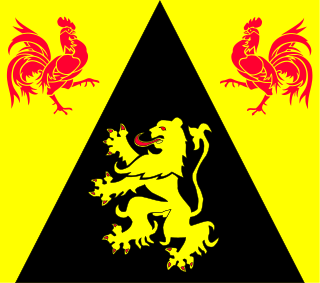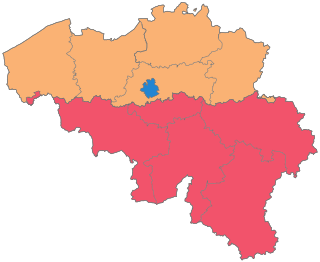Brabant is a traditional geographical region (or regions) in the Low Countries of Europe. It may refer to:
Brabant is a traditional geographical region (or regions) in the Low Countries of Europe. It may refer to:

Flanders is the Dutch-speaking northern portion of Belgium and one of the communities, regions and language areas of Belgium. However, there are several overlapping definitions, including ones related to culture, language, politics, and history, and sometimes involving neighbouring countries. The demonym associated with Flanders is Fleming, while the corresponding adjective is Flemish, which can also refer to the collective of Dutch dialects spoken in that area, or more generally the Belgian variant of Standard Dutch. The official capital of Flanders is the City of Brussels, although the Brussels-Capital Region that includes it has an independent regional government. The powers of the government of Flanders consist, among others, of economic affairs in the Flemish Region and the community aspects of Flanders life in Brussels, such as Flemish culture and education.

North Brabant, also unofficially called Brabant, is a province in the south of the Netherlands. It borders the provinces of South Holland and Gelderland to the north, Limburg to the east, Zeeland to the west, and the Flemish provinces of Antwerp and Limburg to the south. The northern border follows the Meuse westward to its mouth in the Hollands Diep strait, part of the Rhine–Meuse–Scheldt delta. North Brabant had a population of about 2,626,000 as of January 2023. Major cities in North Brabant are Eindhoven, Tilburg, Breda, its provincial capital 's-Hertogenbosch, and Helmond

Limburg, also known as Belgian Limburg, is a province in Belgium. It is the easternmost of the five Dutch-speaking provinces that together form the Region of Flanders, one of the three main political and cultural sub-divisions of modern-day Belgium.

Walloon Brabant is a province located in Belgium's French-speaking region of Wallonia. It borders on the province of Flemish Brabant and the provinces of Liège, Namur and Hainaut. Walloon Brabant's capital and largest city is Wavre.

Liège is the easternmost province of the Wallonia region of Belgium.

The Kingdom of Belgium is divided into three regions. Two of these regions, Flanders and Wallonia, are each subdivided into five provinces. The third region, Brussels, does not belong to any province and nor is it subdivided into provinces. Instead, it has amalgamated both regional and provincial functions into a single "Capital Region" administration.

Dilbeek is a municipality in the province of Flemish Brabant, in the Flemish region of Belgium. The municipality comprises the villages of Dilbeek proper, Groot-Bijgaarden, Itterbeek, Schepdaal, Sint-Martens-Bodegem, and Sint-Ulriks-Kapelle. Dilbeek is located just outside the Brussels-Capital Region, in the Pajottenland, hence the local name Poort van het Pajottenland. Even though Dilbeek is located in the Dutch language area of Belgium, there is a French-speaking minority represented by 3 members on the 35-seat local council. It is a mostly residential community with some preserved rural areas and some industrial zones.

The Southern Netherlands, also called the Catholic Netherlands, were the parts of the Low Countries belonging to the Holy Roman Empire which were at first largely controlled by Habsburg Spain and later by the Austrian Habsburgs until occupied and annexed by Revolutionary France (1794–1815).

The Flemish Region, usually simply referred to as Flanders, is one of the three regions of Belgium—alongside the Walloon Region and the Brussels-Capital Region. Covering the northern portion of the country, the Flemish Region is primarily Dutch-speaking. With an area of 13,522 km2 (5,221 sq mi), it accounts for only 45% of Belgium's territory, but 57% of its population. It is one of the most densely populated regions of Europe with around 490/km2 (1,300/sq mi).

Brabantian or Brabantish, also Brabantic or Brabantine, is a dialect group of the Dutch language. It is named after the historical Duchy of Brabant, which corresponded mainly to the Dutch province of North Brabant, the Belgian provinces of Antwerp and Flemish Brabant as well as the Brussels-Capital Region and the province of Walloon Brabant. Brabantian expands into small parts in the west of Limburg, and its strong influence on the Flemish dialects in East Flanders weakens toward the west. In a small area in the northwest of North Brabant (Willemstad), Hollandic is spoken. Conventionally, the Kleverlandish dialects are distinguished from Brabantian, but for no reason other than geography.

The Duchy of Limburg or Limbourg was an imperial estate of the Holy Roman Empire. Much of the area of the duchy is today located within Liège Province of Belgium, with a small portion in the municipality of Voeren, an exclave of the neighbouring Limburg Province. Its chief town was Limbourg-sur-Vesdre, in today's Liège Province.
The Generality Lands, Lands of the Generality or Common Lands were about one-fifth of the territories of the United Provinces of the Netherlands, that were directly governed by the States-General. Unlike the seven provinces of Holland, Zeeland, Utrecht, Guelders, Overijssel, Friesland and Groningen, these territories had no States-Provincial and were not represented in the central government. At the time of the Union of Utrecht, these territories were under Spanish control, and would only be conquered by the Dutch Republic later in the war. From an economic point of view, they were exploited with heavy taxes and levies.

The Duchy of Brabant, a state of the Holy Roman Empire, was established in 1183. It developed from the Landgraviate of Brabant of 1085–1183, and formed the heart of the historic Low Countries. The Duchy comprised part of the Burgundian Netherlands from 1430 and of the Habsburg Netherlands from 1482, until it was partitioned after the Dutch revolt of 1566–1648.

The Province of Brabant was a province in Belgium from 1830 to 1995. It was created in 1815 as South Brabant, part of the United Kingdom of the Netherlands. In 1995, it was split into the Dutch-speaking Flemish Brabant, the French-speaking Walloon Brabant and the bilingual Brussels-Capital Region.
The Landgraviate of Brabant was a small medieval fiefdom west of Brussels, consisting of the area between the Dender and Zenne rivers in the Low Countries, then part of the Holy Roman Empire.

The Kingdom of Belgium has three official languages: Dutch, French, and German.
Dutch dialects are primarily the dialects that are both cognate with the Dutch language and spoken in the same language area as the Dutch standard language. They are remarkably diverse and are found within Europe mainly in the Netherlands and northern Belgium.

The history of Flanders concerns not only the modern Dutch-speaking part of Belgium, which is now called "Flanders", but also several neighbouring territories and populations. Its historical core territory was in western Belgium between the coast and the Scheldt river.

Flemish (Vlaams) is a Low Franconian dialect cluster of the Dutch language. It is sometimes referred to as Flemish Dutch, Belgian Dutch, or Southern Dutch. Flemish is native to the region known as Flanders in northern Belgium; it is spoken by Flemings, the dominant ethnic group of the region. Outside of Belgium Flanders, it is also spoken to some extent in French Flanders and the Dutch Zeelandic Flanders.
The Dutch language used in Belgium can also be referred to as Flemish Dutch or Belgian Dutch. Dutch is the mother tongue of about 60% of the population in Belgium, spoken by approximately 6.5 million out of a population of 11 million people. It is the only official language in Flanders, that is to say the provinces of Antwerp, Flemish Brabant, Limburg, East Flanders and West Flanders. Alongside French, it is also an official language of Brussels. However, in the Brussels Capital Region and in the adjacent Flemish-Brabant municipalities, Dutch has been largely displaced by French as an everyday language.